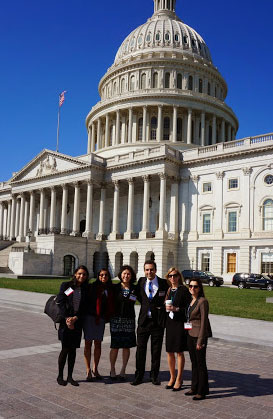Rep. Raul Ruiz, D-Calif., was addressing a group of fellow physicians before our much-anticipated visit to Capitol Hill. While he spoke, I pictured a version of Dr. Ruiz’s teenage self, dressed in a thick, itchy, poorly fitted blue suit in 100° weather soliciting donations to fund his college education. Dr. Ruiz told the group he wrote and signed a contract with contributing members of his community, promising to return as a physician.
He kept that promise. Though Dr. Ruiz grew up in a trailer as the son of farmworkers, he became the first Latino to earn three degrees from Harvard University, including his MD. He then returned home and worked as an ER doctor in Coachella Valley before deciding to run for Congress as a way to improve the lives of his patients and hometown.
His story was an inspiring start to Congressional Advocacy Day, at which I, too, would advocate for my patients. Prior to visiting the Hill, I had a limited understanding of the issues. My meetings with legislators and their staffs showed advocacy in action.
Eye Doctor, Please
Now that more citizens have health insurance coverage under the Affordable Care Act, demand for health provider services has increased. However, not all providers have the same training background. It is often hard for patients to distinguish one from the other based on self-promotional advertising. The Truth in Healthcare Marketing Act (H.R. 1427) strengthens the Federal Trade Commission’s authority to challenge misleading marketing by health care providers on a national level. It promotes transparency and empowers patients to make informed choices.

More than 150 advocacy ambassadors took part in Congressional Advocacy Day, April 10. Dr. Bagheri (right) joined ophthalmologists including, left to right: Sonya B. Shah, MD; Nisreen K. Mesiwala, MD; and Wills Eye Institute residents Teri T. Kleinberg, MD; Ehsan Rahimy, MD; and Blair K. Armstrong, MD. Photo: Courtesy of Dr. Bagheri
Although in Pennsylvania (and in 16 other states), we are fortunate to have a similar law on the state level, this issue resonated with me. There have been countless times I’ve seen ER patients who presented with poorly controlled diabetic retinopathy or other advanced eye disease. In too many cases, the patient thought she or he had received comprehensive care from an “eye doctor,” when perhaps the patient had only seen an optician or had not received an early enough referral from an optometrist.
In reality, if I had no connection to the field, I, too, would find the difference in provider type — and definitely the spelling — confusing. But the issue of patients being confused about their care provider is not unique to our field. The access to scrubs and white coats so ubiquitous among health and non-health care professions only increases confusion. H.R. 1427 would help remedy the problem.
The Regenerating Patch
I was less familiar with another issue addressed on Advocacy Day, however. Every year, advocacy veterans go to the Hill to encourage Congress to repeal the sustainable growth rate (SGR) formula. But when this topic was introduced during a Wednesday night briefing session before Advocacy Day, whispers went around amongst newbies like me. “What is this SGR thing?”

The Pennsylvania contingency prepares to meet with Sen. Bob Casey in the Russell Senate Building. Photo: Sonya B. Shah, MD
I learned that the SGR formula is a flawed way for Medicare to control spending on physician services. The medical community has worked for more than a decade to repeal the SGR formula. This year, we had the most viable opportunity to date as the Congressional Budget Office estimated cost to repeal was the lowest it’s ever been.
The enthusiasm for potential action grew and a bill was created that passed the House. Unfortunately, bipartisan cooperation got hung up over where the money to pay for this would come from. ‘House of Cards’-type behavior set in, and the leadership did not bring the bill forward. Instead, they quickly presented another SGR patch for a voice vote when opposing members were not present to call for a recorded vote. I was shocked to discover that real life politics could be “just like TV.”
It was eye opening to suddenly learn about so many issues that directly affect my future, of which I was previously unaware. When speaking with ophthalmologists who have repeatedly visited the Hill and advocated for the same issue over and over, it was easy to imagine becoming disillusioned with the process. They told me, however, that Congress moves slowly (slower than medicine!) and despite very small steps, we are making a difference.
Overall, Advocacy Day was an intriguing experience — from the Philadelphia sports posters and jars of candy in the congressmen’s offices to the pink marble floors and huge sky-lit atrium featuring the Alexander Calder sculpture “Mountains and Clouds” in the Hart Senate Building. I am thankful to have had the opportunity to visit Capitol Hill and learn firsthand how the process works.
Advocacy Day also showed me how proud I am of our groundbreaking field. Not only do we have a huge societal impact by reducing the burden of eye disease and disability, but we also continue to push the envelope with many innovative projects in the pipeline. Seeing this large group of ophthalmologists coming together to discuss the issues and our future plans renewed my passion for our profession.
As residents, we are the generation inheriting these responsibilities. Hopefully getting an early start will better prime us to take on these challenges as we step up to the plate.
* * *
About the author: Nika Bagheri, MD, is a first-year resident at Wills Eye Hospital. She was selected by Wills, along with Blair Armstrong, MD, and Teri Kleinberg, MD, to participate in the Academy’s 2014 Advocacy Ambassador Program. Originally from Los Angeles, she received her undergraduate degree in neurobiology from the University of California, Irvine before completing medical school at the Cleveland Clinic Lerner College of Medicine.